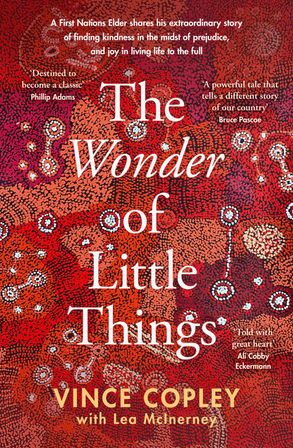The wonder of little things by Vince Copley with Lea McInerney

Vince Copley speaks to all of us in his clear, unequivocal voice. His mother told him ‘always remember you’re as good as anybody else’ and this, amongst other truths, was the mainstay of his life.
Vince Copley died in January 2022. He was a man for whom life was full of the wonder of little things as he took what happened in his stride, making the most of opportunities presented to him. A strong mother with a robust work ethic helped cement early attitudes which he held dear.
Born Vincent Warrior in 1936 at Point Pearce on South Australia’s Yorke Peninsula, his father died of TB when Vince was one year old. Vince’s mother later remarried and the family moved to Leigh Creek then Alice Springs in search of work. Vince began using his mother’s partner’s name, Copley. In Alice Springs he met a group of boys when they came home for summer holidays from St Francis House, a home for Aboriginal boys in Semaphore where they lived in term time, attending local schools. Vince was accepted at St Francis House when he was eleven and lived with a group of other young men destined to become well known for their activism, among them Charlie Perkins, John Moriarty and Gordon Briscoe who became equally well known for their sporting prowess.
Set up by the Anglican Church, St Francis House was run by people who supported young men from Aboriginal communities, helping them through school, on the sporting field and on to work. On leaving the home in 1952, Vince worked in a variety of areas, first as an apprentice boiler maker, then for a time as a professional AFL footballer in Melbourne. Homesick, he came back to the Yorke Peninsula where he worked stacking grain, finding firm friends on a farm near Curramulka, working in the area, eventually successfully coaching the local football team to four premierships, and meeting Brenda Thomas, the woman who would become his wife and mother to their two children.
But his life also reflects the injustices under which Aboriginal people lived: at a town in New South Wales where he went to pick up a grain elevator for the farm, he and his Aboriginal companions were ignored by locals when asking directions; he had to apply to go to Point Pearce to see his family; women refused to dance with him, and he needed to apply for an exemption to move about his own country. That he was not counted in Australia’s census until the 1967 Referendum, nor allowed to vote, and had no rights as a citizen is a stain for all of us to share. Vince presents this as part of the background of his life, with equanimity, armed with his mother’s sage advice that he is as good as anyone else. But the racist nature of the communities in which he moved is there for all to see. And his life story brings other events to the fore, events instrumental in changing attitudes leading to the referendum in 1967. The catalogue of protests, events and marches form a chronology of the Aboriginal rights movement in the mid twentieth century to now and Vince was directly involved with many of them. He was both a participant and a witness to so many changes inherent in making a positive difference to Aboriginal people in Australia.
This memoir is an important catalogue of those changes from one man who was both involved and an astute observer. And his observations will sit with the readers for a long time after the book is finished.
Talking with Lea McInerney over countless cups of tea, Vince said that Reconciliation meant black and white walking together, and this mantra shines through.
The whole book is a fascinating insight into the life of one man but also the strength of the movement for Aboriginal rights. The Tent Embassy figures prominently, while Charlie Perkins and Doug Nicholls amongst others, influenced Vince’s life prodigiously, involving him in an array of government departments set up to address the injustice doled out to Aboriginal people. During the bicentennial celebrations, a source of great disgruntlement to many, Charlie organised a cricket team to tour England, replicating the one sent in 1836. Forty good players had to be whittled down to just thirteen so Vince took another team to New Zealand so as not to disappoint the cricketers.
This little story tells lots about this man, making sure people are included, finding a way to satisfy those who may be left out, solving a problem with aplomb.
In the last section of the book is a timeline of Australia’s history from the first years of Aboriginal occupation, the exploration by people from overseas, European settlement, conflict, the South Australia Act and the early contact with Aboriginal people in SA. The timeline shows the history of SA highlighting Aboriginal people and the effects that government policies have had on them since 1836.
I heartily recommend this highly readable book, it is a wonderful memoir of a man working for the advancement of Aboriginal people, a life well lived and documented with grace. Lea McInerney has developed a blog that contains recordings of Vince talking, his history, Papa Joe and Grandfather Barney, historical archives, and much more.
Themes: Aboriginal people, Glanville House, Ngadjuri, Racism, Yorke Peninsula, Tent Embassy.
Fran Knight